- Scientific name: Cyperus subsquarrosus
- Species of Greatest Conservation Need (MA State Wildlife Action Plan)
- Threatened (MA Endangered Species Act)
Description
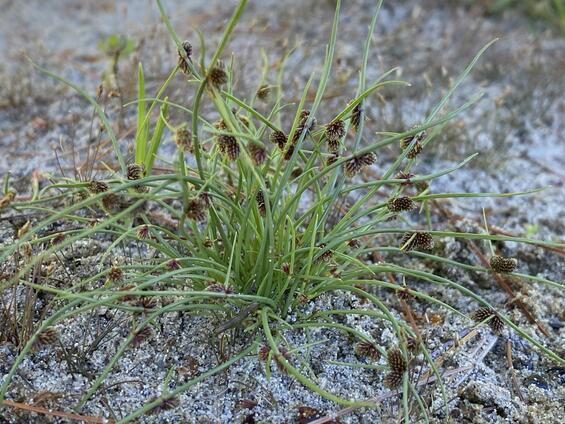
Dwarf Bulrush whole plant in habitat.
Dwarf bulrush (Cyperus subsquarrosus) is a tiny, wiry annual sedge (family Cyperaceae), which inhabits sandy to peaty shores of low-nutrient ponds and lakes. In Massachusetts, its primary habitat is coastal plain ponds.
Reaching just 2-20 cm (<0.1–8 in) in height, this tiny bulrush grows in small tufts and has very slender stems, leaves and bracts. The stems are up to 10 cm (4 in) in length (and are often shorter), and just 0.5 mm (0.02 in) wide. The terminal bract appears to be a continuation of the stem, and the inflorescence appears lateral. The stem bears 1-3 egg-shaped spikelets, each with numerous spirally-arranged, overlapping scales. The scales are 1-2 mm (0.04-0.08 in) long and narrowly rounded with a small awn (sharp tip). The flowers, which develop beneath the scales, have both female and male parts, and no bristles. The fruit, an achene, is cylindric, iridescent brown, with no tubercle, and is 0.5-0.7 mm (0.02-0.03 in) long.
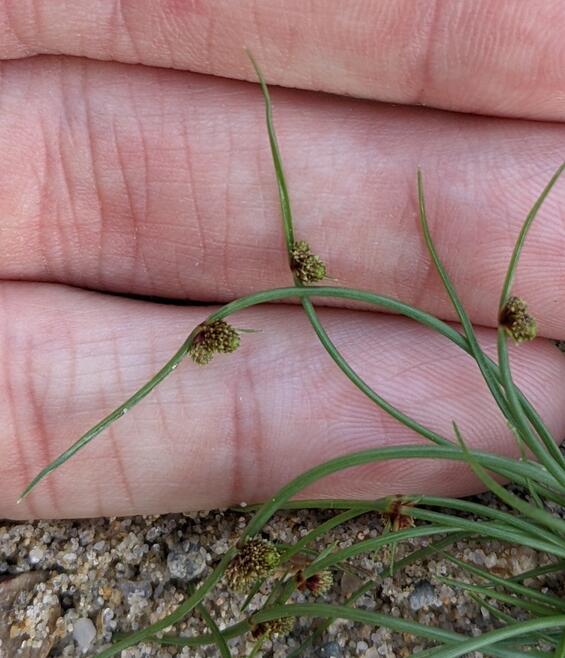
Dwarf Bulrush close up of flowering spikelet.
When examined at maturity, dwarf bulrush is not likely to be confused with other bulrushes in Massachusetts, due to its dwarf size and slender foliage. It resembles a miniature bulrush (Schoenoplectus spp.) with the upright bract. A species it superficially resembles, and which occurs in the same habitat, is autumn fimbry (Fimbristylis autumnalis). Autumn fimbry has small fruiting heads about the same size as dwarf bulrush, but it has forked stems, terminal fruiting heads and usually grows taller than dwarf bulrush.
Life cycle and behavior
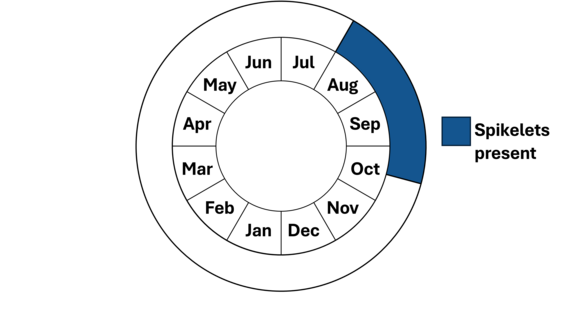
Dwarf bulrush is an annual species that starts to grow when water levels in ponds drop and expose and area of sandy beach. In years when the water levels stay high in a pond, this species will not grow. This is a small species which has a short window for growing and produces fruit from August through mid-October. Its seed falls on the sand near the plant and is spread by wind, wave and water flow in the pond. As is true for most species in the sedge family, it is wind pollinated.
Population status
Dwarf bulrush is listed under the Massachusetts Endangered Species Act as Threatened. All listed species are legally protected from killing, collection, possession, or sale, and from activities that would destroy habitat and thus directly or indirectly cause mortality or disrupt critical behaviors. Each occurrence of dwarf bulrush in a pond is considered a separate population even if the ponds are only 60 m (200 ft) apart. There are currently 32 occurrences of dwarf bulrush in the state verified since 1999 found in Barnstable, Dukes, Franklin, Hampden, and Middlesex, Plymouth, Worcester Counties. There are 35 historical occurrences but only 18 of those have specific locational information. The historical occurrences are located in the same counties as above, plus Essex County. Approximately half of the current populations are ranked as good or better.
Distribution and abundance
The range of dwarf bulrush is broad, encompassing nearly all of the eastern and midwestern states, and Canadian provinces Quebec, Ontario, and British Columbia. Its range includes a portion of the west and southwest into Mexico. The native range also extends into Latin American and northern portions of South America as well a few African countries including Madagascar (POWO 2025). In North America, it is of conservation concern in many states, including Delaware, Kansas, Louisiana, Maryland, Montana, New Jersey, New York, North Carolina, North Dakota, Ohio, Oregon, Pennsylvania, South Carolina, and Virginia. It is also of conservation concern in all the Canadian provinces where it has in the past or currently is known. In New England, dwarf bulrush is critically imperiled in Connecticut, Maine, New Hampshire, and Rhode Island. It is considered imperiled in Massachusetts and is not known to occur in Vermont.
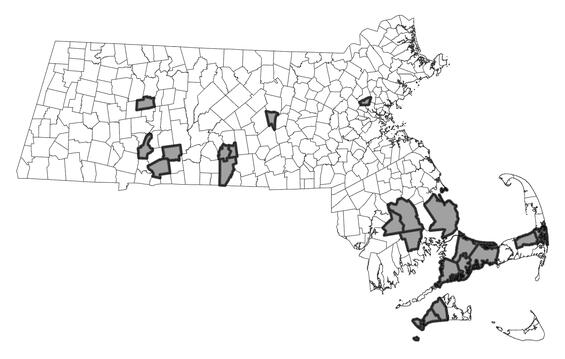
Distribution in Massachusetts. 1999-2024. Based on records in the Natural Heritage Database.
Habitat
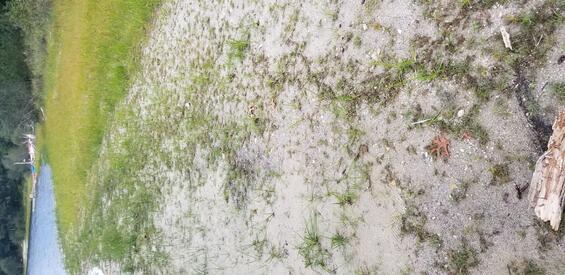
Dwarf Bulrush coastal plain pondshore habitat.
Dwarf Bulrush inhabits sandy to peaty, gently sloping shores of acidic, low-nutrient freshwater ponds with dramatic water-level fluctuation. This annual sedge germinates in a band of shore exposed following late season water-level recession. In Massachusetts, it is found along the shores of coastal plain ponds, and of ponds outside of the coastal plain that have similar hydrology, and water chemistry.
Associated species include several species of flatsedge (Cyperus spp.), autumn fimbry (Fimbristylis autumnalis), Canadian St. John’s-wort (Hypericum canadense), golden hedge-hyssop (Gratiola aurea), and several species of spike-sedge (Eleocharis ssp.)
Healthy habitats are vital for supporting native wildlife and plants. Explore habitats and learn about conservation and restoration in Massachusetts.
Threats
Threats to dwarf bulrush include any activities that change the natural hydrology, water quality, or soil integrity of its habitat. Examples include water table drawdown from local wells, eutrophication resulting from nutrient inputs from septic systems and lawns, and trampling and soil disturbance due to recreational use of pondshores (i.e., hiking, sunbathing, swimming, fishing, boat-launching, and raking or digging). Sea level rise also threatens all species on the coastal plain pondshores as the higher saltwater levels push freshwater levels higher as well, and shoreline plants may not have sufficient time to grow and set seed. Changes in the weather conditions, including extended periods of rainfall and extended periods of drought will both impact dwarf bulrush (Staudinger et al. 2024).
Conservation
Survey and monitoring
Dwarf bulrush populations should be monitored regularly to identify possible threats. This species is best surveyed when mature fruit are present, mid-August to late September, depending on when water levels recede. Also, its habitat should be monitored for exotic plant species invasions. The nature of coastal plain ponds makes them generally inhospitable to many exotic plants, but they can become established at sites that have major soil disturbance or heavy nutrient inputs. Exotic species that could establish along the shoreline of coastal plain ponds include common reed (Phragmites australis ssp. australis), gray willow (Salix cinerea), and purple loosestrife (Lythrum salicaria).
Management
Preservation of dwarf bulrush requires protection of the natural hydrology, water quality, and soil integrity of its habitat. Like other pondshore plant species that inhabit late-season exposed shores, it requires pronounced water-level fluctuations, and acidic, nutrient-poor water and substrate, free from major soil disturbance.
Protection of dwarf bulrush may require exclusion of new wells and septic systems, prohibitions on fertilizer use, and restrictions on recreational use of the pondshores. Recreational activities such as swimming, fishing, and boat-launching should be diverted from plant population locations by providing alternative locations for these activities.
All active management of rare plant populations (including invasive species removal) is subject to review under the Massachusetts Endangered Species Act and should be planned in close consultation with MassWildlife’s Natural Heritage & Endangered Species Program.
Research needs
Research is needed on the long-term viability of the seed when inundated for extended periods. Research questions include: Can seed sprout after being inundated for 10 years, 20 years, or longer? How much genetic variability do the smaller, more isolated populations have; is it sufficient to maintain the population over the long term? This is a wind pollinated species, but it is also only a few centimeters tall. Is there sufficient cross-pollination within a pond and a pond complex to maintain this species?
References
Arsenault, Matt, Glen H. Mittelhauser, Don Cameron, Alison C. Dibble, Arthur Haines, Sally C. Rooney, and Jill E. Weber. 2013. Sedges of Maine, A Field Guild to Cyperaceae. University of Maine Press, Orono, Maine.
Fernald, M. L. 1950. Gray’s Manual of Botany, Eighth (Centennial) Edition—Illustrated. American Book Company, New York.
Gleason, Henry A., and Arthur Cronquist. Manual of Vascular Plants of Northeastern United States
and Adjacent Canada, Second Edition. Bronx, NY: The New York Botanical Garden, 1991.
Haines, A. 2011. Flora Novae Angliae – a Manual for the Identification of Native and Naturalized Higher Vascular Plants of New England. New England Wildflower Society, Yale Univ. Press, New Haven, CT.
NatureServe. 2025. NatureServe Network Biodiversity Location Data accessed through NatureServe Explorer [web application]. NatureServe, Arlington, Virginia. Available https://explorer.natureserve.org/. Accessed: 4/10/2025.
POWO (2025). Plants of the World Online. Facilitated by the Royal Botanic Gardens, Kew. Published on the Internet; https://powo.science.kew.org/ Accessed: 4/10/2025.
Staudinger, M.D., A.V. Karmalkar, K. Terwilliger, K. Burgio, A. Lubeck, H. Higgins, T. Rice, T.L. Morelli, A. D'Amato. 2024. A regional synthesis of climate data to inform the 2025 State Wildlife Action Plans in the Northeast U.S. DOI Northeast Climate Adaptation Science Center Cooperator Report. 406 p. https://doi.org/10.21429/t352-9q86
Contact
| Date published: | May 7, 2025 |
|---|